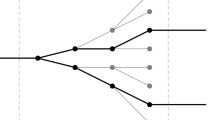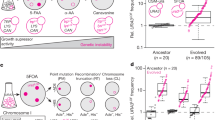Abstract
Spontaneous thioguanine-resistant mutants were derived from populations of finite-life-span, diploid human fibroblasts by means of a fluctuation analysis. cDNA was prepared from mutantHPRT mRNA and amplified by the polymerase chain reaction, and the sequence of the product was analyzed. Exon deletions, which very likely arose from mutations in the intron splice site consensus sequences, were found in 10 of the 37 mutants examined (27% of the total). Among the 28 mutations in the coding sequence, base pair substitutions predominated (89%). With the exception of one base pair involved in a tandem mutation, all base pair substitutions resulted in alterations in the predicted amino acid sequence of the protein. In addition there were three frameshift mutations, consisting of the deletion of one or two base pairs. Although mutations occurred throughout the coding sequence, 50% (14/28) were found in the 5′ portion of exon 3.
Similar content being viewed by others
Literature cited
van Zeeland, A.A., and Simons, J.W.I.M. (1976).Mutat. Res. 34149–158.
Preston-Martin, S., Pike, M.C., Ross, R.K., Jones, P.A., and Henderson, B.E. (1990).Cancer Res. 507415–7421.
Ames, B.N., and Gold, L.S. (1990).Science 249970–971.
Lutz, W.K. (1990).Mutat. Res. 238287–295.
Tindall, K.R., and Stankowski, L.F. (1989).Mutat. Res. 220241–253.
Ashman, C.R., and Davidson, R.L. (1987).Proc. Natl. Acad. Sci. U.S.A. 843354–3358.
Ikehata, H., Akagi, T., Kimura, H., Akasaka, S., and Kato, T. (1989).Mol. Gen. Genet. 219349–358.
deJong, P.J., Grosovski, A.J., and Glickman, B.W. (1988).Proc. Natl. Acad. Sci. U.S.A. 853499–3503.
Nalbantoglu, J., Phear, G., and Meuth, M. (1987).Mol. Cell. Biol. 71445–1449.
Phear, G., Armstrong, W., and Meuth, M. (1989).J. Mol. Biol. 209577–582.
Luria, S.E., and Delbrück, M. (1943).Genetics 28491–511.
Yang, J.L., Maher, V.M., and McCormick, J.J. (1989).Gene 83347–354.
Chen, R.H., Maher, V.M., and McCormick, J.J. (1990).Proc. Natl. Acad. Sci. U.S.A. 878680–8684.
Chen, R.H., Maher, V.M., and McCormick, J.J. (1991).Cancer Res. 512587–2592.
Yang, J.L., Chen, R.H., Maher, V.M., and McCormick, J.J. (1991).Carcinogenesis 1271–75.
McGregor, W.G., Chen, R.H., Lukash, L., Maher, V.M., and McCormick, J.J. (1991).Mol. Cell. Biol. 111927–1934.
McCormick, J.J., and Maher, V.M. (1981). InTechniques in DNA Repair, Vol. 1, (eds.) Friedberg, E.C., and Hanawalt, P.C. (Marcel Dekker, New York), pp. 501–521.
Ryan, P.A., McCormick, J.J., and Maher, V.M. (1987).Exp. Cell Res. 172313–328.
Meuth, M. (1990).Biochim. Biophys. Acta 10321–17.
Mitchell, P.J., Urlaub, G., and Chasin, L. (1986).Mol. Cell. Biol. 61926–1935.
Harwood, J., Tachibana, A., and Meuth, M. (1991).Mol. Cell. Biol. 113163–3170.
Streisinger, G., Okada, Y., Emrich, J., Newton, J., Tsugita, A., Terzaghi, E., and Inouye, M. (1966).Cold Spring Harbor Symp. Quant. Biol. 3177–84.
Bartlett, M.H., Adra, C.N., Park, J., Chapman, V.M., and McBurney, M.W. (1991).Somat. Cell Mol. Genet. 1735–47.
Ames, B.N. (1983).Science 2211256–1264.
Hsie, A.W., Recio, L., Katz, D.S., Lee, C.Q., Wagner, M., and Schenley, R.L. (1986).Proc. Natl. Acad. Sci U.S.A. 839616–9620.
Shigenaga, M.K., Gimbro, C.J., and Ames, B.N. (1989).Proc. Natl. Acad. Sci. U.S.A. 869697–9701.
Shibutani, S., Takeshita, M., and Grollman, A.P. (1991).Nature 349431–434.
Wood, M.L., Dizdaroglu, M., Gajewski, E., and Essigman, J.M. (1990).Biochemistry 297024–7032.
McBride, T.J., Preston, B.D., and Loeb, L.A. (1991).Biochemistry 30207–213.
Lindahl, T., and Nyberg, B. (1972).Biochemistry 113610–3618.
Lindahl, T. (1990).Mutat. Res. 238305–311.
Schaaper, R.M., Kunkel, T.A., and Loeb, L.A. (1983).Proc. Natl. Acad. Sci. U.S.A. 80487–491.
Sagher, D., and Strauss, B. (1983).Biochemistry 224518–4526.
Loeb, L.A., and Cheng, K.C. (1990).Mutat. Res. 238297–304.
Melton, D.W. (1987). InOxford Surveys on Eukaryotic Genes, Vol. 4, (ed.) Maclean, N. (Oxford University Press, Oxford), pp. 34–76.
Author information
Authors and Affiliations
Rights and permissions
About this article
Cite this article
McGregor, W.G., Maher, V.M. & McCormick, J.J. Kinds and locations of mutations arising spontaneously in the coding region of theHPRT gene of finite-life-span diploid human fibroblasts. Somat Cell Mol Genet 17, 463–469 (1991). https://doi.org/10.1007/BF01233170
Received:
Revised:
Issue Date:
DOI: https://doi.org/10.1007/BF01233170




